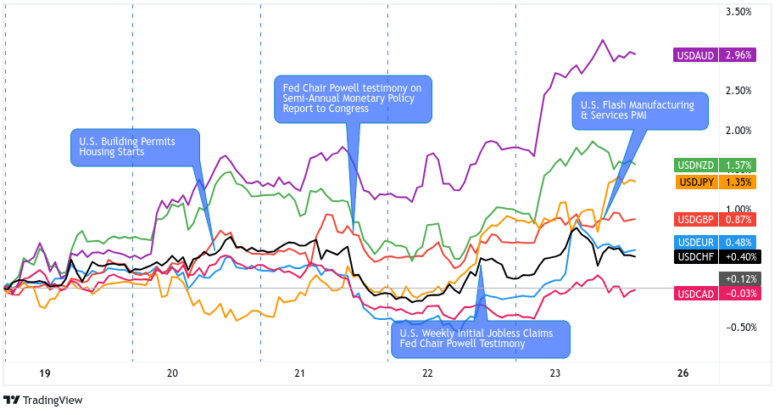A busy week for central banks means forex playas had a lot of repricing to do!
Less-hawkish-than-expected meeting minutes from the BOJ and RBA dragged the Australian dollar and the yen throughout the week, while growth concerns also pulled the British pound lower.
Meanwhile, the U.S. dollar benefited from hawkish testimonies from Powell as well as some good old risk aversion, falling only to the Loonie by the Friday close.
USD Pairs

Overlay of USD vs. Major Currencies Chart by TV
Risk aversion and expectations of hawkish testimonies from Fed Governor Powell gave the dollar a boost early in the week, especially against “risker” bets like AUD and NZD.
The Greenback lost some of its intraweek gains when Powell hinted at at least two more rate hikes this year but wasn’t too clear about when those increases may happen.
Traders eventually processed the Fed’s rate hike intentions on Thursday, however, and the dollar soon made new intraweek highs against its major counterparts.
? Bullish Headline Arguments
Treasury Secretary Yellen said she sees lower U.S. recession risk, consumer slowdown needed to contain inflation.
In her remarks at a community event, Fed Board of Governors member Michelle Bowman said that “additional policy rate increases will be necessary to bring inflation down to our target over time.”
Powell on Thursday: FOMC members “do think that there are more rate hikes coming but we want to make them at a pace that allows us to see incoming information.”
Existing Home Sales for May: +0.2% m/m to 4.3M unites(-0.5% m/m forecast; -3.2% m/m previous);
During his testimony before the House Financial Services Committee, Fed Chair Powell warned that below-trend growth is likely needed; likely more rate hikes ahead but likely at a more moderate pace and based on data.
Building Permits for May: 1.49M (1.425M forecast; 1.42M previous); Housing Starts at 1.63M vs. 1.4M forecast
NAHB: U.S. homebuilder sentiment jumped from 50 to an 11-month high of 55 in June as limited supply continued to encourage new construction
? Bearish Headline Arguments
Current Account for Q1 2023: -$219.3B (-$218.2B forecast; -$216.2B previous)
Chicago Fed National Activity Index for May: -0.15 (0.15 forecast; 0.14 previous)
Initial weekly jobless claims for the week ending June 17: 264K vs. 271K the previous week
EUR Pairs

Overlay of EUR vs. Major Currencies Chart by TV
The euro started the week on a mixed note as traders focused more on currencies with central bank events like AUD, JPY, GBP, and USD.
The common currency started gaining ground mid-week when the ECB’s hawkish bias stood out while markets worried about global growth trends.
EUR fell sharply on Friday, however, when manufacturing and services PMIs from Germany, France, and the Eurozone hit multi-month lows, but was still able to come out as a net winner at the Friday close.
? Bullish Headline Arguments
Euro area Flash consumer confidence for June: +1.3 points to -16.1; EU was +1.1 points to -17.2
European Central Bank Executive Board member Schnabel sees prices rising due to corporate profits and higher salaries
Euro Area Current Account for April: €4B surplus vs. €31B surplus in March
Slovakia’s central bank chief Peter Kazimir said on Monday that the ECB should raise interest rates again in July
? Bearish Headline Arguments
HCOB Eurozone Manufacturing PMI slipped from 44.8 to a 37-month low of 43.6 in June, Services PMI also hit a five-month low from 55.1 to 52.4.
Deteriorating demand conditions dragged HCOB Germany Manufacturing PMI from 43.2 to 41.0 (37-month low) in June while the Services PMI dropped from 57.2 to a 3-month low of 54.1
HCOB France Manufacturing PMI dipped from 45.7 to a 37-month low of 45.5 in June; Services PMI also weakened from 52.5 in May to a 28-month low of 48.0 in June
Germany Producer Prices Index for May: -1.4% m/m (-0.6% m/m forecast; +0.3% m/m previous)
GBP Pairs
The pound was all over the place in the first half of the week while traders priced in their BOE decision speculations.
GBP made new intraweek lows when the U.K. dropped higher-than-expected inflation in May. The U.K.’s consumer price inflation index rose by 8.7% y/y in May, which might force the BOE to raise its rates above the possibly recession-inducing 6.0%.
The currency recovered some of its losses when the BOE surprised markets with a 50bps rate hike instead of the 25bps that markets were expecting and then extended its gains when the U.K. printed better-than-expected consumer confidence and retail sales data on Friday.
? Bullish Headline Arguments
Retail sales slowed down from 0.5% m/m to 0.3% m/m in May (but vs. -0.2% m/m expected) thanks in part to warm weather boosting non-store retail activity
GfK consumer confidence rose for a fifth month in a row, up from -27 to -24 in June despite stubbornly high inflation and interest rates
Bank of England surprised with a 50 bps interest rate hike to 5.00% on Thursday with a 7-2 vote
U.K.’s inflation remains at 8.7% y/y in May, marking the fourth month in a row that CPI exceeded market estimates
? Bearish Headline Arguments
S&P Global U.K. Manufacturing PMI dropped from 47.1 to a six-month low of 46.2, while the Services PMI also weakened from 52.8 to a three-month low of 52.8
Factory gate prices were up by 2.9% ytd/y in May vs. a 5.2% increase in April
Producer input prices were up by 0.5% ytd/y in May, down from a 4.2% increase in April
Rightmove: Asking prices for British homes fell in June for the first time in six years, thanks to higher mortgage and interest rate expectations
CHF Pairs
The safe haven franc lost a few pips on Tuesday when traders were favoring the U.S. dollar ahead of Powell’s testimony.
CHF started gaining ground mid-week when the markets were turning their focus on higher interest rates and possibly lower global growth prospects.
The franc largely remained within wide ranges except against the Aussie and Kiwi which were weighed by risk aversion.
? Bullish Headline Arguments
SNB raised its interest rates by 25bps to 1.75%, its highest since April 2002. Chairman Jordan doesn’t rule out further rate hikes.
Trade surplus expanded from 2.56B CHF to 5.48B CHF in May as exports (+21.1%) surpassed imports (+7.3%) growth
AUD Pairs

Overlay of AUD vs. Major Currencies Chart by TV
The Australian dollar was the biggest loser this week thanks to overall risk aversion and the RBA apparently not being as hawkish as investors thought earlier when members raised their rates in June.
AUD lost pips against all of its major forex counterparts, with CAD and USD seeing the most gains against the comdoll.
? Bullish Headline Arguments
Manufacturing PMI rose from 48.4 to a three-month high of 48.6 in June as production shrank at its slowest pace since February
? Bearish Headline Arguments
Services PMI fell from 52.1 to 50.7 even as businesses continued to hire additional staff in June
Westpac-Melbourne leading index further declined from -0.78% to -1.09% in May, the tenth consecutive negative print for the index
RBA meeting minutes showed rate hike arguments were “finely balanced,” as members weighed inflation risks, tight labor market, and rising home prices
CAD Pairs
The Canadian dollar was the biggest winner this week despite falling oil prices and broad risk-off sentiment.
An argument can be made that due to positive Canadian updates (solidifying further the resiliency of the Canadian economy), the Loonie was an attractive short-term alternative to the net negative counter currency narratives and risk-off vibes that persisted this week.
? Bullish Headline Arguments
Retail Sales for April 2023: +1.1% m/m (+0.2% m/m forecast; -1.5% m/m previous); core retail sales was +1.3% m/m (+0.2% m/m forecast; -0.4% m/m previous)
New Housing Price Index for May: +0.1% m/m (-0.2% m/m forecast; -0.1% m/m previous)
? Bearish Headline Arguments
Industrial PPI for May: -1.0% m/m vs. -0.6% m/m in April; Raw Materials Price Index fell -4.9% m/m vs. +1.8% m/m in April
NZD Pairs
Like the Aussie, the Kiwi also fell victim to China’s growth concerns and overall risk aversion in the first half of the week.
Unlike AUD, though, NZD recovered some of its losses and even maintained its wide ranges against most of its counterparts until a wave of selling late Thursday pulled it down to its intraweek lows near the end of the week.
? Bullish Headline Arguments
Global Dairy Trade Price Index: average price holds at $3.479 at the latest auction
Westpac: New Zealand consumer sentiment index up from 77.7 to 83.1 in June but households remain deeply pessimistic amidst high living costs and mortgage rates
BusinessNZ Services Index is up by 3.2 points from an upwardly revised 50.1 in April to 53.3 in May. All five measures showed expansion.
? Bearish Headline Arguments
New Zealand’s trade surplus narrowed down from 148.2M NZD to 46M NZD in May as imports (+4.4% y/y) outpaced exports (+2.8% y/y)
JPY Pairs

Overlay of JPY vs. Major Currencies Chart by TV
Global growth concerns early in the week pushed the safe haven yen higher against its counterparts.
The BOJ rained on the yen bulls’ parade, though, when its meeting minutes hinted that BOJ members are still confident about keeping their policies accommodative while their counterparts are tightening their policies.
JPY fell almost steadily on Wednesday and Thursday. It wasn’t until Friday when the Eurozone printed disappointing PMI reports that the yen recovered a bit, but ultimately falling to yen selling pressure into the weekend.
? Bullish Headline Arguments
National core CPI, which excludes volatile fresh food prices, came in at 3.2% y/y in May, higher than the expected 3.1% y/y but slower than April’s 3.4% y/y reading
BOJ’s meeting minutes showed one member wanting to ensure that their policy “does not fall behind the curve” as wages and inflation accelerate
? Bearish Headline Arguments
au Jibun Bank flash Japan manufacturing PMI dropped from 50.6 to a contractionary 49.8 in June as both output and new orders declined while new orders dropped at their steepest pace since February
This post first appeared on babypips.com












